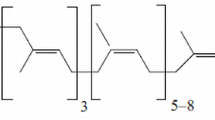Abstract
By a new technique a peptidoglycolipid has been isolated from virulent mycobacteria. This macromolecular complex lipid substance has been identified as wax D by infrared spectrophotometric and chromatographic analysis. The peptide portion consists of the aminoacids DAP, Ser, Glu, Ala, Val and Ileu. The constituents of the polysaccharide portion are lactose, glucose, and arabinose. The lipid portion contains mycolic acid, phthienoic acid, lignoceric acid, tuberculostearic acid, oleic acid, and two not yet identified acids with more than 30 C-atoms.
In healthy animals wax D evokes characteristic tissue alterations such as specific epitheloid cell granulomatas, caseation, and calcification. On the other hand, by application of peptide-free substances as PmKo-glycolipid, cord factor-glycolipid, wax C as well as mycolic acid and phthienoic acid no such tissue reactions could be observed.
On the basis of the different chemical structure of the lipid substances under investigation the following conclusions can be drawn: the high-molecular peptidoglycolipid is that toxic mycobacterial compound which is responsible for the specific inflammatory tissue reaction and its peptide portion is the determining constituent.
Zusammenfassung
Aus virulenten Mycobakterien wurde durch eine neue Technik ein Peptidoglykolipid isoliert, das durch infrarotspektrophotometrische und chromatographische Analyse als D-Wachs bestimmt wurde. Es ist eine makromolekulare, komplexe Lipid-Verbindung. Ihr Peptid-Teil besteht aus DAP, Ser, Glu, Ala, Val, Ileu. Der Polysaccharid-Teil besteht aus Laktose, Glukose und Arabinose, der Lipid-Teil aus Mykolsäure, Phthionsäure, Lignocerinsäure, Tuberkulostearinsäure, Ölsäure und zwei bis jetzt nicht bestimmten Säuren mit mehr als 30 C-Atomen.
D-Wachs ruft in gesunden Tieren charakteristische Gewebeveränderungen hervor, wie spezifische Epitheloidzellgranulome, Verkäsungen und Kalkablagerungen. Dagegen wurde nach Applikation der peptidfreien Stoffe: PmKo-Glycolipid, Cord-Factor-Glycolipid, C-Wachs sowie Mycol- und Phthionsäure keine spezifische Gewebereaktion festgestellt.
Auf Grund des Unterschiedes in der chemischen Struktur der untersuchten Lipid-Substanzen werden folgende Schlußfolgerungen gezogen: Die toxische mycobakterielle Verbindung, die für die Entstehung der spezifischen entzündlichen Gewebsveränderungen verantwortlich ist, ist das hochmolekulare Peptidoglycolipid; der entscheidende Bestandteil seines Makromoleküls ist der Peptid-Teil.
Similar content being viewed by others
Literatur
Asselineau, J.: Les lipides bacteriens. Paris: Herman 1962.
Ballou, C. E., Vilkas, E., Lederer, E.: Structural studies on the myo-inositol phospholipids of Mycobacterium tuberculosis (var. bovis, strain BCG). J. biol. Chem.238, 69 (1963).
Chaput, M., Michel, G., Lederer, E.: Structure du mycoside C m , peptido-glycolipide de M. marianum. Biochim. biophys. Acta (Amst.)63, 310 (1962).
—— —— —— Structure du mycoside C2 de M. avium. Biochim. biophys. Acta (Amst.)78, 329 (1963).
Choucroun, N.: Antigenic carbohydrate-lipid, isolated from paraffin oil extract of dead tubercle bacilli. Science46, 105 (1947).
Crowder, J. A., Stodola, F. H., Pangborn, M. C., Anderson, R. J.: The chemistry of the lipids of tubercle bacilli. XLIV. Comparative study of the lipids of the human tubercle bacillus. J. Amer. chem. Soc.58, 636 (1936).
Demarteau-Ginsburg, H., Lederer, E.: Sur la structure chimique du mycoside B. Biochim. biophys. Acta (Amst.)70, 442 (1963).
Gabler, E., Pendel, O., Stöchl, W.: Untersuchungen über die Wirkung der leicht löslichen Lipide des Tuberkelbacillus (H37Rv) bei intrapulmonaler Applikation. Beitr. Klin. Tuberk.129, 122 (1964).
Gerstl, B., Tenannt, R., Pelzmann, O.: Cellular reactions to mycolic acids. Amer. J. Path.21, 1007 (1945).
Gusek, W., Kracht, J.: Cytomorphologisch-histochemische und autoradiographische Befunde am Mycolsäuregranulom des Meerschweinchens. Beitr. Klin. Tuberk.129, 67 (1964).
Husseini, H., Elberg, S.: Cellular reactions to phthienoic acid and related branched-chain acids. Amer. Rev. Tuberc.65, 655 (1952).
Jollès, P., Samour, D., Lederer, E.: Analytical studies on wax D, a macromolecular peptidoglycolipid fraction from human strains of M. tuberculosis. Arch. Biochem. Suppl.1, 283 (1962).
—— Samour-Migliore, D., DeWijs, H.: Correlation of adjuvant activity and chemical structure of mycobacterial wax D fractions: the importance of amino sugars. Biochim. biophys. Acta (Amst.)83, 361 (1964).
Lederer, E.: Biogenese, Struktur und biologische Wirkung der Lipoide des Tuberkelbazillus. Angew. Chem.76, 241 (1964).
Pokorný, J., Žák, F.: Mycobacterial lipids. Prague: DILIA 1965.
—— Šulová, J., Žák, F.: Experimental immunity against tuberculosis evoked by peptidoglycolipids of the wax D type. Z. Immun.-Forsch.138, 118 (1968).
Sabin, F. R.: Cellular reactions to fractions isolated from tubercle bacilli. Physiol. Rev.12, 141 (1932).
Smith, D. W., Randal, H. M., MacLennan, A. P., Lederer, E.: Mycosides: a new class of type-specific glycolipids of mycobacteria. Nature (Lond.)186, 887 (1960).
Yamamura, Y., Yasaka, S., Nakamura, S., Yamagushi, M., Ogawa, L., Endö, K., Takagushi, H.: Recherches sur la formation de cavernes par les constituants des bacilles tuberculeux. Ann. Inst. Pasteur20, 51 (1956).
Author information
Authors and Affiliations
Rights and permissions
About this article
Cite this article
Pokorný, J., Žák, F. Über die chemische Struktur von D-Wachs und seine Wirkung auf Gewebe. Pneumologie 142, 231–241 (1970). https://doi.org/10.1007/BF02095221
Issue Date:
DOI: https://doi.org/10.1007/BF02095221




